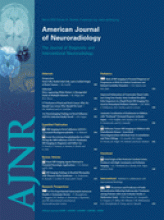Abstract
BACKGROUND AND PURPOSE: CBV is a key parameter in distinguishing penumbra from ischemic core. The purpose of this study was to compare CBV measurements acquired with standard PCT with ones obtained with C-arm CT in a canine stroke model.
MATERIALS AND METHODS: Under an institutionally approved protocol, unilateral MCA strokes were created in 10 canines. Four hours later, DWI was used to confirm the presence of an infarct. CBV maps acquired with PCT were compared with ones acquired by using C-arm CT. Three experienced observers, blinded to the technique used for acquisition, evaluated the CBV maps.
RESULTS: An ischemic stroke was achieved in 9 of the 10 animals. Areas of reduced CBV were detected in 70%–75% of the PCT studies and in 83%–87% of the C-arm CT examinations, with false-positives in 1.7% and 3.3%, respectively. False-negatives were found in 25% of the PCT and 12.2% of the C-arm CT studies. In all studies, there was a significant difference between the absolute CBV values in normal and abnormal tissue (P < .005) and no significant difference between PCT and C-arm CT CBV values in either the normal or the abnormal parenchyma (P > .05).
CONCLUSIONS: CBV measurements made with C-arm CT compare well with ones made with PCT. While further work is required both to fully validate the technique and to define its ultimate clinical value, it appears that it offers a feasible method for assessing CBV in the angiography suite.
Abbreviations
- ACA
- anterior cerebral artery
- CBF
- cerebral blood flow
- CBV
- cerebral blood volume
- DWI
- diffusion-weighted imaging
- DSA
- digital subtraction angiography
- FN
- false-negative
- FP
- false-positive
- ICA
- internal carotid artery
- MCA
- middle cerebral artery
- MTT
- mean transit time
- PCT
- perfusion CT
- TP
- true-positive
- VA
- vertebral artery
- Copyright © American Society of Neuroradiology











